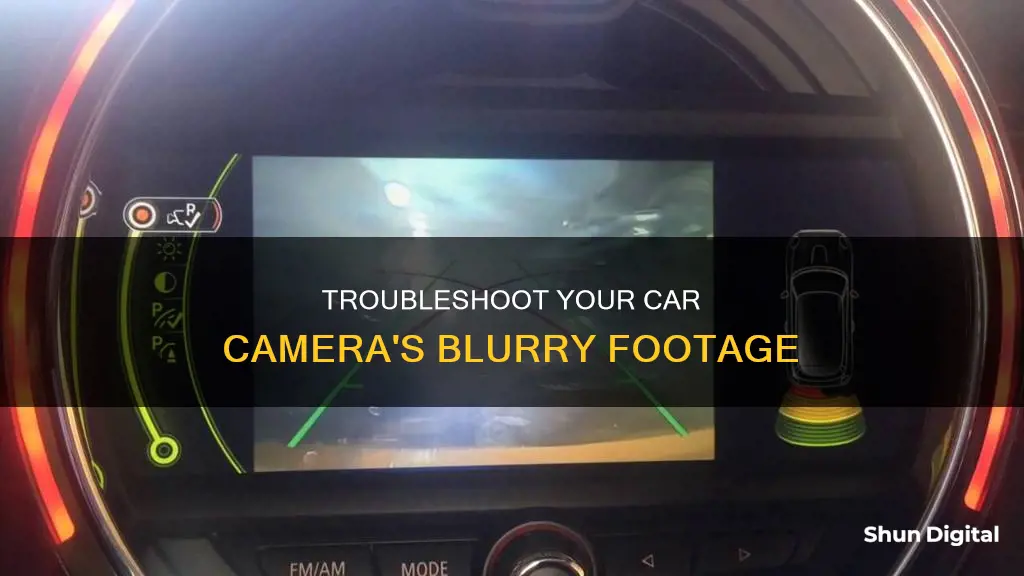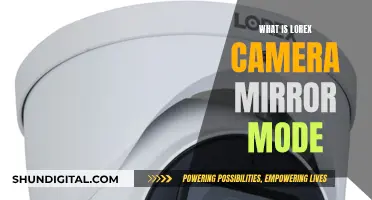
A blurry car camera can be a source of frustration and compromise safety while driving. There are several reasons why your car camera may be blurry, and addressing the issue is important for a better driving experience and safer navigation. The problem could be due to hardware damage, such as a broken lens, stabilizer, or other components. It is also possible that dirt, fog, or water has accumulated on the lens, causing blurry images. Loose connections between the camera and the screen could be another factor. In addition, constant movement and displacement of the camera due to rough terrain or improper installation can result in blurry images. Older rearview cameras may also lack the necessary features, such as sensors and night mode, leading to blurry images. To fix the issue, it is recommended to inspect the camera for any worn-out parts or loose screws and to clean the lens gently with a microfiber cloth. Checking for condensation and fixing faulty connections are also important steps. If the problem persists, consulting a professional or the camera's manual for further troubleshooting tips is advised.
| Characteristics | Values |
|---|---|
| Poor specs | High-quality cameras transmit high-quality images |
| Camera displacement or constant shaking | Tighter screws can help |
| Glare | |
| Damaged or dirty lens | Mud, dirt, and water can cause blurriness |
| Condensation | Interior condensation can be caused by loose screws or broken parts |
| Faulty connections | Poor installation, damaged wiring, or moisture on cable connectors |
| Old and worn-out rear view camera | Outdated features, poor image quality, damaged components |
| Lack of proper and regular maintenance |
What You'll Learn

Dirty lens
A dirty lens is one of the most common reasons for blurry images. Dirt, dust, fingerprints, and other debris on the lens can cause blurry, foggy, or flare video results, affecting the fine detail of recordings. Even in daytime conditions, dirt and scratches can cause a loss of contrast, which may go unnoticed and therefore unaddressed.
To clean your dashcam lens, use a non-scratch lens cloth, optionally dampened with isopropyl alcohol. Avoid chemical cleaners and solvents, which can damage plastic components. Wipe the lens gently, allowing it to air-dry afterward.
It is recommended to clean your camera lens regularly to improve the quality of recorded videos and avoid blurry footage.
Russian Cars and Cameras: Standard Feature or Optional Extra?
You may want to see also

Hardware damage
If your car camera is blurry, it could be due to hardware damage. This could be a result of unexpected wear and tear while driving. In this case, you should check if your backup camera is working properly and try connecting it to a different source. If the camera is still blurry, you may need to visit a professional to get it fixed.
If the lens of your car camera is broken or damaged, it can also cause the view to be blurry. This could be due to condensation or the accumulation of water droplets on the lens. To fix this, you can try drying the camera by placing it in a bowl of uncooked rice or exposing it to sunlight. You should also check for any cracks in the camera and seal them to prevent further damage.
In some cases, the stabilizer of your car camera may be broken, causing blurry images. This is considered hardware damage and would require the assistance of a professional to repair or replace the stabilizer.
Additionally, internal condensation can also cause hardware damage to your car camera. If there is too much condensation in your car, water can enter the electrical system of the camera and damage it. To prevent this, regulate the airflow to get rid of the condensation and ensure that all cracks in the camera are sealed.
If your car camera continues to produce blurry images even after attempting these fixes, it may be best to replace the camera or the entire system.
Surveillance at Lot E Lax: Are You Being Watched?
You may want to see also

Poor installation
First, decide on the optimal position for your dashcam. It should be within arm's reach of the driver's seat, but not obstructing your view of the road. Ideally, place it near the centre rear-view mirror, giving it a good view of the road while keeping it out of your field of view.
Next, carefully route the power cable from the dashcam to the fuse box. Tuck the cable neatly along the headliner, down the A-pillar, and behind the interior panels to the fuse box. Ensure you know the location of your vehicle's fuse box, usually found underneath the dashboard or inside/underneath the glove box.
When connecting the dashcam to the fuse box, locate a "hot in start" fuse. This type of fuse only has power when the vehicle is running, ensuring the dashcam turns on and off with the ignition. Use a circuit tester to identify the correct fuse.
After connecting the dashcam to the fuse, ground the dashcam wiring to your vehicle. Locate a ground point near the fuse box and secure the ground lug from the installation kit to the vehicle's metal body.
Finally, test your installation. Insert the key into the ignition and turn it to the "run" position. If installed correctly, the dashcam should turn on and begin recording. Ensure the camera is properly focused and provides a clear, unobstructed view of the road.
By following these steps and paying attention to the details, you can avoid issues with blurry footage due to poor installation.
Unlocking Camera Mode in Smash Melee: A Step-by-Step Guide
You may want to see also

Condensation
Check for Internal Condensation:
- Inspect your car for internal condensation, especially after rain or when the heat is turned on.
- Regulate the airflow to reduce condensation.
- If your camera is damaged by condensation, try drying it by placing it in a bowl of uncooked rice or exposing it to sunlight.
- Once dry, inspect the camera for cracks and seal them to prevent further damage.
Prevent Condensation:
- Ensure proper ventilation in your car to reduce moisture buildup.
- Use a hairdryer to keep the camera lens clear of condensation.
- Consider using battery-operated heaters that attach to the camera lens hood.
- Use hand warmers with double-sided tape or Velcro to attach to the outside of the lens hood.
Address Moisture Entry Points:
- Inspect your car for any cracks or openings that may allow moisture to enter.
- Seal any identified entry points to prevent moisture from reaching the camera.
- Ensure that the camera lens is properly sealed and protected from the elements.
Replace the Camera:
- If condensation issues persist, consider replacing the camera with a new one.
- Consult a professional to ensure proper installation and sealing of the new camera.
Charging the Canon Powershot A620: A Quick Guide
You may want to see also

Old camera
If your car's backup camera is blurry, it could be due to a number of reasons, including hardware damage, dirt on the lens, or loose connections. Here are some detailed explanations and fixes for an old car camera that is blurry:
Exterior Damage
The backup camera may have sustained unexpected wear and tear while driving, resulting in blurry images or videos. In such cases, it is recommended to check if the camera is functioning properly and, if necessary, consult a professional for hardware repairs.
Dirty Lens
A blurry backup camera can often be caused by a dirty lens. Dirt, rain, snow, fog, or mud accumulation on the lens can blur its view. To fix this, use a microfiber cloth to gently wipe the lens with a cleansing solution, removing any stains. Some cameras also offer an auto-cleansing feature to keep the lens clean.
Internal Condensation
Internal condensation in your car can also cause the backup camera to malfunction. Rain or the use of heating inside the vehicle can lead to condensation buildup, which can damage the camera if not addressed. Regulate the airflow to reduce condensation, and if the camera is damaged, dry it using uncooked rice or sunlight.
Loose or Faulty Connections
The backup camera is connected to the front screen, and loose or faulty connections between them can result in blurry images. Perform a complete diagnostic check to ensure all connections are secure, and check the fuse box for any blown fuses.
Camera Age
Finally, it is important to consider the age of your car camera. Older cameras may not have the same image quality or functionality as newer models. If all other solutions fail to improve the blurriness, it may be time to upgrade to a new camera or system.
Charging Olympus Stylus Tough Camera: A Step-by-Step Guide
You may want to see also







